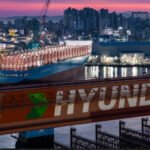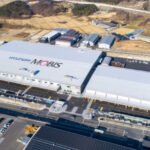Foreign workers enter South Korea through Incheon International Airport
On Aug. 31, 2004, 92 Filipinos, wearing a T-shirt and a white cap, entered Incheon International Airport – determined to make money in South Korea and return home with a fortune.
Those Philippine workers with the Korean dream were the first batch of foreigners allowed to set foot on Korean soil, a relatively better-off country, under Korea’s foreigner employment permit system introduced a couple of weeks earlier.
Twenty years later, the number of foreign workers reached over 1 million, playing a critical role across industries that Koreans shun due to harsh work and scant salary.
According to the Ministry of Employment and Labor, the cumulative number of foreign workers allowed to enter Korea under the employment permit system stood at 1,001,106 as of the end of the first half, up from 961,347 at the end of 2023.
The foreign workers who came from 17 countries have worked in five allowed sectors – manufacturing, construction, agriculture, fisheries and services.
(Graphics by Dongbeom Yun)
Currently, 247,191 foreign workers are working in those industries, accounting for 4.6% of the industries’ entire workforce.
VIETNAMESE LEADING THE PACK
Over the past two decades, a total of 4,846,935 foreigners from 17 countries that signed a worker dispatch agreement with Korea have taken work skills and Korean language proficiency tests to obtain an E-9 visa to work in Korea. Of these, 1,001,106 people passed the tests and were deployed to 79,399 workplaces, supporting largely the manufacturing, construction, agriculture, livestock and fishing industries that Koreans avoid.
Vietnam has sent the most workers with 146,283 people arriving in Korea over the past 20 years. At its peak, 20,075 Vietnamese entered Incheon International Airport with the Korean dream in 2008.
Indonesia came in second with 113,131 workers coming to Korea over two decades, followed by Thailand (107,561), Cambodia (104,018) and Nepal (99,899).
Migrant workers at Incheon International Airport
Of the 247,191 foreigners working in Korea in 2023, 80.6% or 199,269 people were engaged in manufacturing, followed by the agricultural and livestock industry (29,250) and the fisheries industry (11,191).
The government has increased the planned annual number of foreign workers to 165,000 this year – its largest ever.
Starting this year, foreign workers can legally work in sectors such as hotels, condominiums, restaurants, meat transport, waste disposal, courier services and airport ground handling.
VIETNAME FAST CLSOING GAP WITH CHINESE
With the Vietnamese topping the list of foreign entrants, the proportion of foreigners, overwhelmingly Chinese for years, is also changing.
As of the end of June|, the number of Chinese foreign residents, including marriage immigrants, overseas students and workers with a work permit, was 952,254 – the largest number and three times more than that of second-ranking Vietnamese with 307,487.
However, excluding the 635,215 ethnic Korean Chinese, pure Chinese residents in Korea stood at 317,039.
Women stand beside a sign advertising jobs for domestic helpers to work abroad, outside an office in Manila (Courtesy of AP via Yonhap)
Among marriage immigrants, Chinese people were 60,281. Excluding the ethnic Korean Chinese, however, the number fell to 39,009 – fewer than the Vietnamese (41,028).
In all types of foreign workers, including skilled workers with the E-7 visa, seasonal workers with the E-8 visa and unskilled E-9 workers, the Chinese were 97,385, more than the Vietnamese (81,744). Excluding the ethnic Korean Chinese, the Vietnamese ranked first.
CONCENTRATED IN SEOUL METROPOLITAN AREA
Foreign workers prefer to work in Seoul and the surrounding metropolitan area where pay and living conditions are better than in other regions.
The proportion of workers in the Seoul metropolitan area increased to 48.7% in 2021 from 44.7% in 2012.
Migrant workers at Incheon International Airport
Last year, 199,269 foreigners in the domestic manufacturing sector were estimated to have made a combined 11 trillion won ($8.2 billion). That’s 2.5 times the 2022 GDP of East Timor, one of the 17 countries that dispatch workers to Korea and is close to Tajikistan’s GDP.
In 2017, the World Bank evaluated Korea’s foreign employment permit system as “an excellent policy that promotes economic growth in worker-dispatching countries.
FOREIGN WORKERS SET TO GROW IN KOREA
Due to Korea’s low birth rate and aging population, foreign workers are expected to increase going forward.
Analysts said Korea now needs to address issues such as improving foreign workers’ work safety and human rights to make the system sustainable.
“To maintain skilled foreign workers to work long-term, Korea should provide them with better support programs such as bringing their families into Korea and comfortably settling in the local community,” said Lee Kyu-yong, a researcher at the Korea Labor Institute.
By Yeong-Hyo Jeong and Yong-Hee Kwak
hugh@hankyung.com
In-Soo Nam edited this article.














